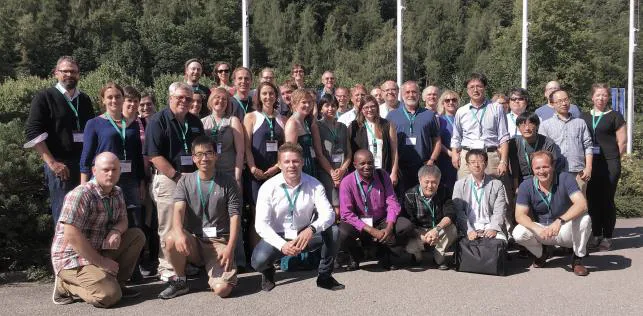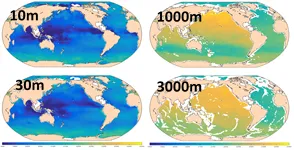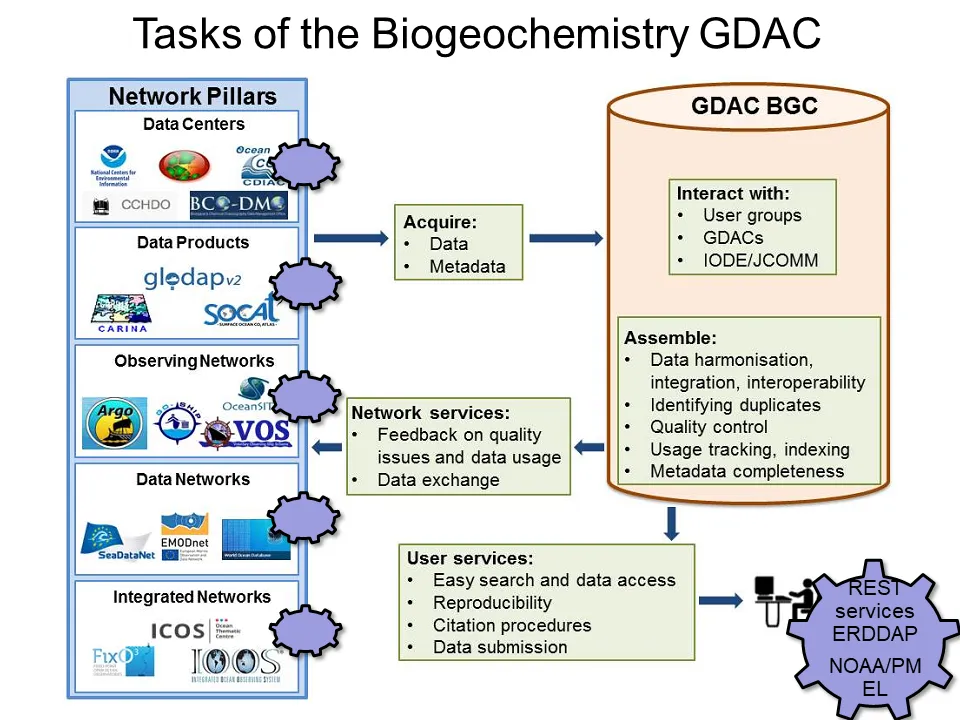The core mission for IOCCP at the 10th International Carbon Dioxide Conference (ICDC10) in Interlaken, Switzerland, was to organize and run a half-day community workshop focused on IOCCP’s activities related to data management and synthesis products development. The IOCCP side-event on “Marine Carbon and Biogeochemistry Data Management and Synthesis” took place on Wednesday, 23rd August 2017 as an official part of ICDC10, and was attended by over 50 scientists from 15 countries.

|
Photo 1. Participants of the IOCCP side event on data management at ICDC10. |
The event highlighted the accomplishments, plans and challenges of communities engaged in delivering to and using existing and planned marine carbon and biogeochemistry data products, such as the Surface Ocean Carbon Dioxide Atlas (SOCAT) or the Global Ocean Data Analysis Project (GLODAP). Representatives of terrestrial and atmospheric carbon cycle research communities actively participated in the event and we used this opportunity to exchange perspectives on presented subjects.
Based on lessons learned during the development of SOCAT and GLODAP, the aim was to discuss (i) the challenges and opportunities related to connecting the carbon and biogeochemistry data currently available from several sources, and (ii) the need to build an integrated access point for several carbon and biogeochemistry data types from various observing platforms (ships, moorings, floats, gliders). Moreover, the five thematic sessions (surface ocean, ocean interior, time series, sensors, and general data management) discussed a pathway towards extending the existing and planned data products beyond primarily carbonate chemistry measurements and into a full scope of biogeochemistry EOVs, which in many cases are measured using novel sensor technology.
The side event focused on five main topics, with presentations and discussions summarized below:
SOCAT – Update and road ahead
Several issues were presented and discussed during the first hour of the event. Based on the density of the agenda and large and active community participation it seems that a dedicated SOCAT-only meeting might be needed in the near future. In this article we highlight four topics, which are most relevant for the general community:
Discussions were continued around possible future inclusion of additional parameters to SOCAT. The SOCAT community agreed to include other surface parameters like nutrients, DIC, TA in SOCAT without quality control and release them in a separate file. This might start for version 7 (2019). There are ongoing discussions regarding the inclusion of surface ocean CH4 and N2O in SOCAT or as a parallel data product using SOCAT infrastructure. The latest aspect of this issue concerns the inclusion of surface ocean fCO2 calculated from other parameters most often based on sensor technology installed on floats and gliders. This issue will be taken further by the SOCAT and relevant IOCCP groups with the initial focus on the quality assessment of such data.
The second aspect concerns automated data upload to SOCAT. After many years of development, all SOCAT data are being submitted through the Upload Dashboard. Several advantages and some challenges were presented and discussed during the meeting. Also general gratitude to the developers of the Dashboard (Benjamin Pfeil and Camila Landa with their team in Bergen, and Kevin O’Brien and Karl Smith with theirs in Seattle).
Thirdly, the progress on the automation of the SOCAT metadata upload was discussed. The aim of the automation is to automate quality control of the metadata, in order to improve the metadata quality and to reduce the quality control effort. The objective is to have the automated metadata upload in place for SOCAT version 7 (2019).

|
Figure 1. SOCAT automation and annual public release diagram. |
Finally, the possible setup of a system for surface ocean methane (CH4) and nitrous oxide (N2O) using SOCAT infrastructure was discussed. There is a growing need for observing non-CO2 greenhouse gases in marine environment, e.g. CH4 and N2O. During the past few years, instruments measuring these two gases with the same frequency as is common for CO2 measurements by IR (infrared) instruments have become available. They can be used in existing setups for surface ocean CO2 measurements without much additional effort. This results in data sets that have CO2 and N2O and/or CH4 measurements combined. There is interest from the observational and modelling community to combine these data streams. Discussions are held with MEMENTO (MarinE MethanE and NiTrous Oxide) scientists regarding the strategy and procedures for such a combined effort to become more globally implemented.
You can read the full description of what was discussed at: https://www.socat.info/index.php/meetings/.
GLODAP – Update and road ahead
Two issues presented and discussed during the GLODAP session are highlighted here.
First is related to data quality control, specifically the pH measurements. Historical potentiometric pH measurements have not been included in GLODAPv2 and this was queried during the discussion. There are at least two challenges related to this issue: (i) often unknown accuracy of the potentiometric pH measurements and (ii) unsatisfactory consistency of seawater CO2 system calculations. For (i) the group decided to form a 'pH task force' within GLODAP, to focus on determining the quality of existing potentiometric pH data and work on their inclusion in the GLODAP data product. For (ii) there is a need for a working group on the improvement of the seawater CO2 chemistry dissociation constants. Possibly a SCOR working group application should be considered.

|
Figure 2. Total inorganic carbon (TCO2) in year 2002 at four different depth levels. Source: GLODAPv2. |
The second theme extensively discussed during the GLODAP session was the inclusion of sensors-based data from biogeochemical profiling floats in the future releases of the data product. The current global network consists of ca. 300 active floats and still needs to undergo a transition to an operational observing system with sustained funding allowing to maintain a network of around 1000 biogeochemical Argo floats, which would need 250 deployments per year. However, data are already being produced in large quantities and global data collections like GLODAP need to start taking advantage of the new technologies allowing to increase the spatial and temporal data coverage. Best practices manuals for data quality assessment need to be updated so that the existing, high accuracy bench-top instrument-based data products could benefit from the ever-increasing sensors-based data stream.
Time Series – Data coverage and availability
The entire discussion that followed the initial presentation was held in the context of the need for the time series community to get somewhat organized in order for coordination efforts of IOCCP, OCB, OceanSITES and others to take place. Whether it’s measurements and data treatment protocols, funding, building capacity through training and otherwise, or developing data synthesis products for various parameters, it’s impossible to coordinate amongst several hundreds of stations on an individual basis. A strong push in this direction was given by the coordination bodies in 2012, when the Global Intercomparability in a Changing Ocean: An International Time-Series Methods Workshop was organized. One of the goals there, was to establish an international network of ship-based time series. The initial steps were taken, but the community needs to capitalize on this effort and formalize the network structure so that at least communication amongst all interested parties is maintained.
Development of a global, time-series based data synthesis product was proposed as an activity promising to attract interest from most sites and therefore serving as an axis for coordination. Such a product would have to serve a (set of) specific science goal(s), that in turn would have to be within scientific interest of participating sites. The ability to observe long term variability in physical, biogeochemical and biological phenomena and short- to long-term interconnectivity between the processes governing this variability, puts time series in a unique position within the global ocean observing system and makes the potential synthesis product(s) an extremely valuable perspective.
Comments from participants were very positive, however it was cautioned that such an effort would require a number of very dedicated champions across disciplines and some dedicated funding for coordination and technical infrastructure.
Autonomous Sensors – What happens between unpacking the box and providing a useful information product
This session looked at almost revolutionary change in requirements, specific needs and capabilities for biogeochemical measurements made with sensors. Widening the scope of sensor measurements beyond the traditional IOCCP-focus centred around carbonate system requires careful assessment of sensors’ capabilities to provide measurements with required accuracy and precision. The development of international standards for sensor operation and data management is critical to assure the quality of the data output in order for the community to be able to develop confidence in the same way we have confidence in the traditional methods of analysing the variables of interest.
The role of the IOCCP and wider GOOS community was discussed in the context of focussing the requirements for sensor measurements of most biogeochemical EOVs. This requires active coordination efforts between sensor manufacturers, the wider scientific community and funding bodies.
A couple of major challenges were highlighted and discussed. The first is the fact that marine biogeochemistry measurements represent a relatively small market for sensor developers and therefore relatively small effort is made by the developers to improve the overall usefulness of any given sensor for individual applications after the product is brought to the market. It is therefore very important that the scientific community gets involved in funding of sensors development so that continued hardware testing and improvement is made possible regardless of perhaps unsatisfying financial gain for the industry. Such active involvement will also help the manufacturer community gain awareness of the requirements we have in terms of accuracy, precision or even the environment we need to work in.
The second major challenge is related to the large gap that exists between the technology already available or being developed and the capacity to use this technology around the world. Besides the financial challenges that need to be overcome in order to acquire the technology, still too many institutions lack the appropriate training in operating the sensors properly. Inter-calibration exercises, user training and development of field guides around sensor operation, data quality control and data management is badly needed. IOCCP with partners tries to fill some of this gap by organizing international training courses on sensor operation but this effort has to be multiplied in order to build global capacity for sensor operation. Several European and USA-funded national and regional projects provide funding for training but the scope is often limited to national/regional personnel. We hope for these efforts to allow participation by a wider, international community in the future.
Carbon Data Management – Challenges and solutions
The entire session was based on issues highlighted and discussed in IOCCP’s position paper on Global Ocean Biogeochemistry Data Management. Progress achieved over the past 2 years and remaining challenges were presented and discussed.
Discussions regarding data interoperability and therefore integration of the community-wide data management efforts filled a considerable part of the session. Currently, data exchange in our community is predominantly based on exchanging physical copies of individual data sets. As a result, seemingly endless number of versions of a given data set reside at various repositories, creating considerable confusion amongst users and making data curation a daunting task. Examples of interoperable data exchange systems working in other communities were briefly described and a schematic solution designed for use in marine biogeochemistry was proposed. When implemented, these services will not only address the version control challenges but, perhaps more importantly, will allow our community to instantly aggregate data from various sources moving our community to the age of Big Data.

|
Figure 3. Anticipated structure of the Global Data Assembly Centre for Marine Biogeochemistry. Source: Benjamin Pfeil. |
Within our community, an illustration of the implementation of the integrated data management was provided based on the European Research Infrastructure Integrated Carbon Observing System (ICOS).
During discussions following the ICOS presentation, it was emphasized that collaboration amongst elements of data management within our community must overcome the currently predominant competition. The key to success seems to be a community-wide agreement allowing individual data centres to focus and specialize in specific services for the community. In such a landscape, a combination of interconnected services provided by highly specialized elements (with modest digital overlap) would provide to the community needs. Each element would clearly communicate its function and funding needs, and therefore funding streams would not be directed to support efforts duplicating existing service-providers as it is often the case today.
Finally, it’s important to state that in a truly interoperable data management system, each nationally or regionally funded data set would be submitted to a data archive designated by a funding agency supporting data collection. The data will be automatically made available throughout the system or public availability will be held for certain period requested by national/regional agreements.
